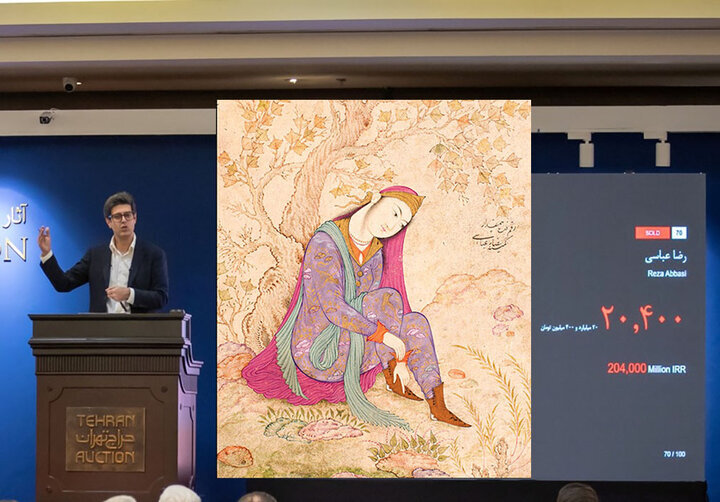Tehran Auction undergoes scrutiny amidst claims of illegal art sale
Tehran Auction undergoes scrutiny amidst claims of illegal art sale
TEHRAN- Following the sale of a historical artwork attributed to the renowned Safavid-era artist Reza Abbasi, controversies arose regarding the legality of the sale and its authenticity.

The sale, which took place at the 22nd Tehran Auction on Friday, has drawn criticism from cultural heritage officials and raised questions among art experts, Mehr reported.
Hours before the auction's commencement, Leila Khosravi, Acting Director General of Museums, voiced concerns over the sale of traditional artworks, some dating back over a century, the report added.
Citing the 1930 Law on the Protection of National and Cultural Heritage, Khosravi emphasized that the export and sale of artifacts older than 100 years are strictly prohibited without explicit permission from the Deputy of Cultural Heritage of the Ministry of Cultural Heritage, Tourism, and Handicrafts.
She further clarified that such artworks can only be sold within Iran after official identification and certification by the ministry.
The Tehran Auction, in its recent edition, showcased a collection of traditional, classical, and modern Iranian arts, including 25 traditional and 75 modern pieces.
Auction organizers, however, asserted that they had secured the necessary permits from the Ministry of Culture and Islamic Guidance, as well as specific authorization from the Ministry of Cultural Heritage, Tourism, and Handicrafts for the sale of artworks exceeding a century in age.
Mahmoud Nourai, public relations director for the Tehran Auction, defended the artwork's provenance, stating that the “Portrait of a Seated Girl” possesses a documented history, tracing back to a gift from the Safavid rulers of Isfahan to a prominent family.
Despite these assurances, Khosravi later issued a statement deeming the artwork's sale illegal.
Adding to the complexity, questions have been raised regarding the authenticity of the Abbasi attribution. Art experts have pointed to discrepancies in handwriting, the absence of certain characteristic techniques, and inconsistencies in the artwork's purported creation date and style.
Despite the concerns, the Tehran Auction has maintained that expert analysis, including paper and color testing, has been conducted.
Furthermore, the auction catalog featured an image of another Reza Abbasi artwork, sold at Christie's in 2018, highlighting the longstanding issue of valuable artworks leaving the country.
This incident underscores the need for stronger measures to control the export of national treasures. By displaying and auctioning the artwork within Iran, the Tehran Auction has seemingly thwarted any attempt to smuggle the artifact out of the country, as well.
The painting “Portrait of a Seated Girl” by Reza Abbasi was the highest-grossing piece at this edition of the auction, which was sold for $264,000 (224.4 billion rials). The second-highest sale was a pair of engraved candlesticks by Hossein Alaghmandan, fetching $134,588 (114.4 billion rials). The third place was shared between the paintings “Genesis” by Mahmoud Farshchian and “Forgiveness” by Wahed Khakdan, both selling for $121,647 (103.4 billion rials).
The first of its kind in Iran, the Tehran Auction was launched in 2012 as an independent and private initiative to introduce the best in Iranian art, ranging from established and emerging Iranian artists to art collectors and the global audience.
It aims to address the increasing interest in modern and contemporary Iranian art and facilitate the acquisition of quality works in reliable ways.
SAB/
source: tehrantimes.com